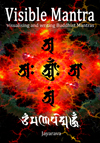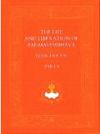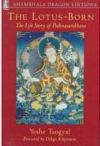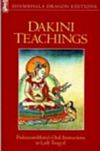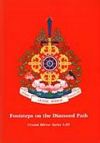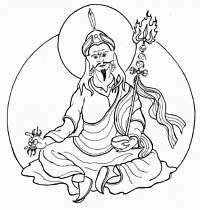
Padmasambhava was probably an historical character, but has been elevated to the Bodhisattva pantheon. He has many different forms. In this image he is portaryed as a siddha, but wears a bhikṣu's robe, a pandit's hat, and the implements of a siddha. In his right hand he brandishes a vajra held in the warding off evil mudra; while in his left hand he cradles a skull cup filled with Amṛta - the ambrosia of the gods which gives immortality. In the crook of his left elbow is his katvanga or magical staff which, like the Śaivas', is a flaming trident decorated with severed heads in various stages of decay.
Padmasambhava played a crucial role in establishing Buddhism in Tibet where he is revered as a second Buddha particularly by the Nyingma School. He used his magical powers to subdue the demons of Tibet in order to allow Buddhism to take root there. In Tibet he is referred to as Guru Rimpoche (Precious Teacher), or the Vajra Guru. His mantra is also known as the Vajra Guru mantra.
The Rigpa Shedra Wiki has a good introduction to the life of Padmasambhava.
Mantra
Siddhaṃ

Tibetan - Uchen

Transliteration
oṃ āḥ hūṃ va jra gu ru pa dma si ddhi hūṃ
oṃ āḥ hūṃ vajraguru padmasiddhi hūṃ
Notes
Footsteps on the Diamond Path contains a commentary on the Vajra Guru Mantra. In this comentary each syllable or word has many esoteric associations. For instance oṃ, āḥ and hūṃ represent the "supreme essence" of Body Speech and Mind (what would be called the Three Mysteries in Shingon, I think). While vajra, guru, padma, siddhi and hūṃ represent the supreme essence of the five Buddha families, which vajra, jewel, lotus, karma, and Tathagata respectively.
As usual the Tibetan for 'vajra' is spelt badzra and pronounced benza.
In Sanskrit the words vajra, guru, padma, and siddhi mean respectively: diamond or thunderbolt; teacher; lotus, and success or accomplishment.
The Thöthrengtsal Mantra
This is another mantra associated with Padmasambhava. It has some Tibetan words in it.

oṃ āḥ hūṃ vajraguru pema thöthrengtsal vajrasamaya jāḥ siddhiphāla hūṃ āḥ
Unicode: ༄ཨོཾ་ཨཱཿ་ཧཱུྂ་བཛྲ་གུ་རུ་པེ་མ་ཐོ་ཐྲ་གྟསལ་བཛྲ་ས་མ་ཡ་ཇཱཿ་སིདྡྷི་ཕ་ལ་ཧཱུྂ་ཨཱཿ།
Notes
- pema = (Sanskrit: padma)
- thöthrengtsal = (Sanskrit: kapalamālā) = garland of skulls.
- vajrasamaya = adamantine bond
- siddhiphāla = the fruit of perfection
The Seven Line Invocation to Padmasambhava
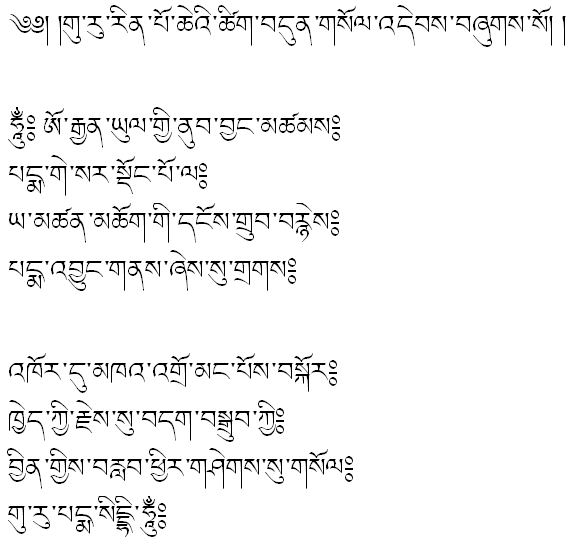
Transliteration
gu ru rin po chei tshig bdun gsol 'tebs bzhugs so
hūṃ o rgyan yul gyi nub byang mtshams |padma ge sar sdong po la |
ya mtshan mchog gi dngos grub brnyes |
padma 'byung gnas zhes su grags |
'khor du mkha' 'gro mang pos bskor |
khyed kyi rjes su bdag bsgrub kyi |
byin gyis brlab phyir gshegs su gsol |
gu ru padma siddhi hūṃ |
Translation
hūṃ To the North-west of the land of Urgyen,
On the calyx of a lotus flower,
O wondrous, the highest siddhi has been attained!
Thus Padmasambhava declares
O thou who art encircled with an entourage of ḍākinīs
Following thy example will I work
Thou must come here to give me thy blessing
guru padma siddhi hūṃ
(Translation by Urgyen Sanghrakshita according to the oral explanation of Dhardo Rinpoche).

